
Apamea is a genus of moths in the family Noctuidae first described by Ferdinand Ochsenheimer in 1816.
Wainscot is a panelling, often wooden, applied to an interior wall of a building.
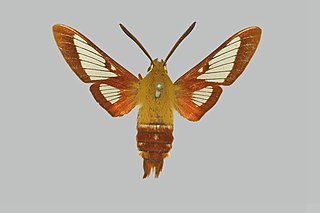
Hemaris gracilis, the slender clearwing or graceful clearwing, is a moth of the family Sphingidae. The species was first described by Augustus Radcliffe Grote and Coleman Townsend Robinson in 1865. It is found in North America from Nova Scotia to central Florida along the East Coast and west through New England to Michigan to Saskatchewan. The species is listed as threatened in Connecticut.

Acronicta lanceolaria, the lanceolate dagger moth or pointed dagger, is a moth of the family Noctuidae. The species was first described by Augustus Radcliffe Grote in 1875. It is found in North America, from Nova Scotia to British Columbia. It is listed as a species of special concern and believed extirpated in the US state of Connecticut.

Psectraglaea is a monotypic moth genus of the family Noctuidae described by George Hampson in 1906. Its only species, Psectraglaea carnosa, the pink sallow, described by Augustus Radcliffe Grote in 1877, is native to North America. It is listed as threatened in Connecticut, and as a species of special concern in Massachusetts.

Apamea cinefacta is a moth of the family Noctuidae first described by Augustus Radcliffe Grote in 1881. It is found in western North America, including in Washington and Alberta.
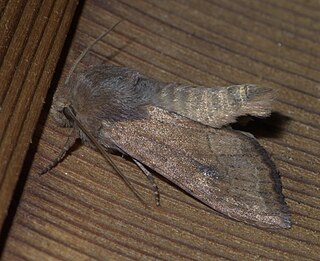
Apamea inficita, the lined Quaker is a moth of the family Noctuidae. The species was first described by Francis Walker in 1857. It is native to North America, where it can be found from Newfoundland west to British Columbia, north to the Yukon and the Northwest Territories, and south to Colorado.
Apamea niveivenosa, the snowy-veined apamea, is a moth of the family Noctuidae. The species was first described by Augustus Radcliffe Grote in 1879. It is native to northern North America, where it can be found across Canada and south to California.
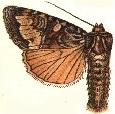
Apamea occidens, the western apamea, is a moth of the family Noctuidae. The species was first described by Augustus Radcliffe Grote in 1878. It is native to western North America as far east as Alberta and Kansas.

Apamea plutonia, the dusky Quaker or dusky apamea, is a moth of the family Noctuidae. The species was first described by Augustus Radcliffe Grote in 1883. It is native to northern North America, where it occurs across the boreal regions, with some occurrences from as far south as New Mexico and Pennsylvania.

Apamea vultuosa, the airy apamea, is a moth of the family Noctuidae native to North America.

Catocala badia, the bay underwing, bayberry underwing or old maid, is a moth of the family Erebidae. It is found from southern Maine and New Hampshire south to New York and Connecticut.

Acronicta falcula, the corylus dagger moth, is a moth of the family Noctuidae. The species was first described by Augustus Radcliffe Grote in 1877. It is found in the United States and Canada from southern New England to southern Manitoba and Iowa. Recently seen from Wisconsin, Connecticut, Rhode Island, New York and Michigan. It is reported as rare in Ohio. It is listed as a species of special concern in the US state of Connecticut.

Apamea inordinata is a moth of the family Noctuidae. It is found in the United States, including New York, Massachusetts, Pennsylvania, Colorado, and California. In Canada it is found in Ontario, Quebec, New Brunswick, Nova Scotia, British Columbia, Alberta, Saskatchewan and Manitoba. Its wingspan is about 34 mm. The species is listed as threatened in Connecticut.
Thaumatopsis edonis is a moth in the family Crambidae. It was described by Augustus Radcliffe Grote in 1880. It is found in North America, where it has been recorded from Florida, Kentucky, Maine, Massachusetts, Mississippi, Missouri, Nebraska, New Jersey, Oklahoma and South Carolina. It is listed as threatened in the US state of Connecticut.
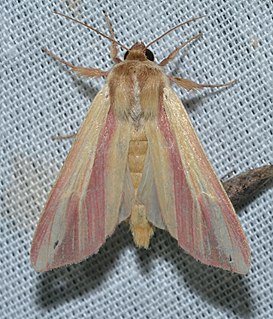
Dargida rubripennis, the pink streak, is a species of moth in the family Noctuidae. It was described by Augustus Radcliffe Grote and Coleman Townsend Robinson in 1870. It is found in the eastern United States, ranging to Kansas and Texas. It is listed as threatened in the US states of Massachusetts and Connecticut. The wingspan is 32–37 mm. The forewings are yellowish-white, with dull pink streaks and shaded with dull pink at the outer margin. The hindwings are white, also shaded with dull pink. Adults are on wing from January to February and from July to October. Its preferred larval host plant is Switchgrass.

Pyreferra ceromatica, the anointed sallow moth, is a species of moth native to North America. In the US state of Connecticut it is listed as a species of special concern and is believed to be extirpated. It was described by Augustus Radcliffe Grote in 1874.
Euxoa violaris, the violet dart moth, is a species of moth native to North America. It is listed as a species of special concern in the US state of Connecticut. It was described by Augustus Radcliffe Grote and Coleman Townsend Robinson in 1868.
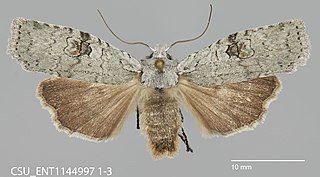
Lithophane viridipallens, the pale green pinion moth, is a moth of the family Noctuidae that is native to North America. It is listed as a species of special concern in the US state of Connecticut. It was described by Augustus Radcliffe Grote in 1877.
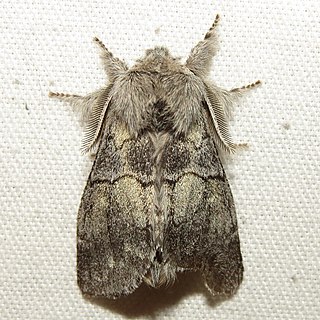
Gluphisia lintneri, the Lintner's gluphisia moth or Lintner's pebble, is a species of moth in the family Notodontidae. It was first described by Augustus Radcliffe Grote in 1877 and it is found in North America.







